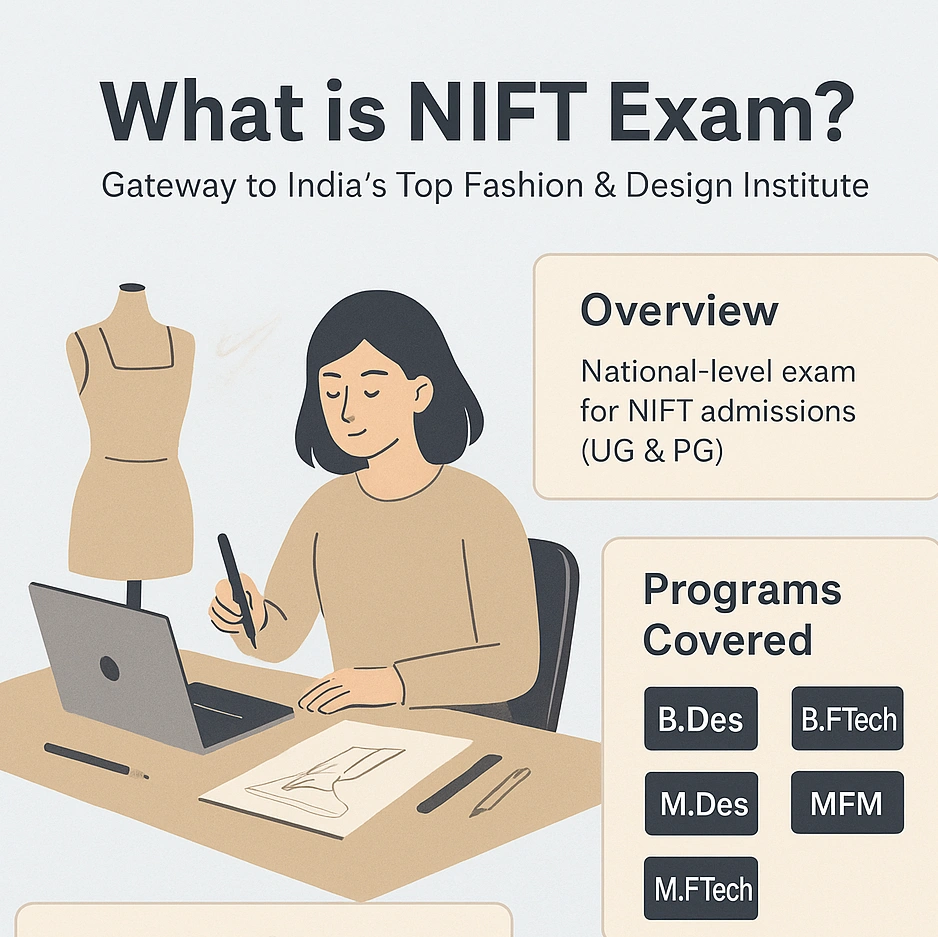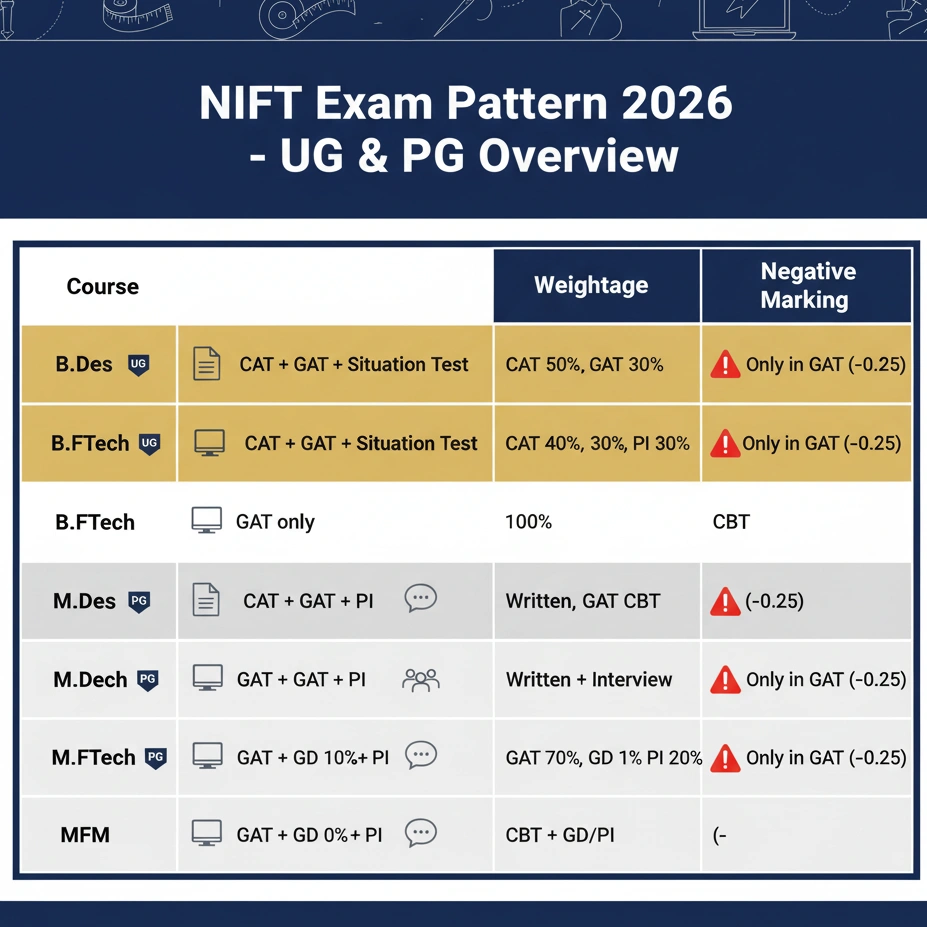Having a clear knowledge of the NIFT exam pattern and syllabus is very essential when preparing for the NIFT exam. This is because, unless your preparation is strategic, it’s very difficult to clear such a highly competitive exam. Every year, thousands of aspirants compete for admission into NIFT. However, only those who have a strategic understanding of the NIFT paper pattern, total marks, and subjects are able to score properly.
This blog breaks down the NIFT syllabus and NIFT exam pattern 2026 for B.Des, B.FTech, and PG courses. It explains the NIFT marking scheme, syllabus, and NIFT Situation Test questions. We have also provided a complete NIFT entrance exam syllabus PDF for you. This guide has everything you need to start your preparation with confidence.
The NIFT entrance exam is the national-level test conducted for admission into the National Institute of Fashion Technology (NIFT). NIFT is one of India’s top fashion and design institutes. It is organised annually. The NIFT entrance exam serves as the gateway to NIFT UG and PG programs in design, fashion technology, and management.
Thousands of students appear for this competitive exam every year. Through this exam, the students secure a seat at NIFT’s 18 campuses across India. The NIFT Delhi campus, however, is the most in demand. It is held in multiple exam centres across India, usually in January or February. Hope, now you have all the answers to your ‘What is NIFT exam’ query.

The NIFT entrance exam syllabus 2026 is divided into two main written tests – GAT (General Ability Test) and CAT (Creative Ability Test) – along with a Situation Test (for B.Des) or GD/PI (for PG). The NIFT syllabus and question distribution vary depending on the program you are applying for.
The GAT is common for UG and PG courses and includes multiple-choice questions.
For M.FTech, a few questions are also based on engineering concepts.
The CAT evaluates a candidate’s:
CAT is conducted for B.Des and M.Des only.
Note: Candidates must not reveal identity on CAT answer sheets; doing so results in disqualification.
Use of outside material or identity marks on models/write-ups leads to disqualification.
Group Discussion (GD): Case-study-based discussion (15–20 minutes) evaluated on:
Personal Interview (PI): Evaluated on:
| Programme | Test | NIFT Subjects | No. of Questions | Duration |
|---|---|---|---|---|
| B.Des | GAT | Communication Ability (25), English Comprehension (25, Quantitative Ability (20), Analytical Ability (15), GK & Current Affairs (15) | 100 | 120 min |
| CAT | Creativity, Observation, Concept Development, Design Ability, Colour & Illustration Skills | Subjective | 120 min | |
| Situation Test | 3D Model Making, Material Handling, Creativity, Innovation, Colour Sense, Write-up (in English) | — | 2–3 hrs | |
| B.FTech | GAT (Section A + Section B) | Communication Ability & English Comprehension (45), Case Study (25), Quantitative Ability (30), Analytical & Logical Ability (25), GK & Current Affairs (25) | 150 | 180 min |
| M.Des | GAT | Communication Ability (30), English Comprehension (30), Quantitative Ability (20), Analytical Ability (25), GK & Current Affairs (15) | 120 | 120 min |
| CAT | Advanced Creativity, Conceptual Thinking, Innovative Use of Design | Subjective | 120 min | |
| PI | Portfolio Review, Design Aptitude, Research Skills, Communication | — | — | |
| M.FTech | GAT | Communication Ability & English Comprehension (45), Case Study (25), Quantitative Ability (30), Analytical & Logical Ability (25), GK & Current Affairs (25) + Engineering-based Questions | 150 | 180 min |
| GD/PI | Case Study Discussion, Managerial Skills, Leadership, Communication | — | — | |
| MFM | GAT | Communication Ability & English Comprehension (50), Case Study (40), Quantitative Ability (20), Analytical & Logical Ability (25), GK & Current Affairs (25) | 150 | 180 min |
| GD/PI | Business Awareness, Managerial Aptitude, Leadership, Communication | — | — |
Many students search for the official NIFT entrance exam syllabus PDF. For your benefit, we have directly provided the NIFT Entrance Exam Syllabus PDF link below.
.png&w=1920&q=75)

The NIFT exam pattern 2026 is structured differently for undergraduate and postgraduate courses. To excel well, knowing the NIFT paper pattern, subjects, and total marks will help you prepare strategically.
| Course | Test Components | Weightage | Mode | Weightage | Negative Marking |
|---|---|---|---|---|---|
| B.Des | CAT + GAT + Situation Test | CAT (50%), GAT (30%), Situation Test (20%) | CAT – Offline, GAT – CBT | 100% | Only in GAT (-0.25) |
| B.FTech | GAT only | 100% | CBT | 100% | Yes (-0.25) |
| M.Des | CAT + GAT + PI | CAT (40%), GAT (30%), PI (30%) | Written + Interview | 100% | Only in GAT (-0.25) |
| M.FTech | GAT + GD + PI | GAT (70%), GD (10%), PI (20%) | CBT + GD/PI | 100% | Yes (-0.25) |
| MFM | GAT + GD + PI | GAT (70%), GD (10%), PI (20%) | CBT + GD/PI | 100% | Yes (-0.25) |
The NIFT entrance exam 2026 has a well-defined marking scheme that varies depending on the course you are applying for. Understanding the NIFT total marks distribution and weightage for each test helps aspirants prepare more strategically and focus on high-scoring sections.
The NIFT exam total marks vary for different courses. The exam has 4 stages whose total marks are as follows:
The NIFT Situation Test is one of the most crucial stages of the admission process for B.Des aspirants. After clearing the CAT and GAT, shortlisted candidates are invited to appear for this test. It is designed to evaluate a student’s practical skills, creativity, and innovative thinking.
Candidates are usually given theme-based design problems. Examples include:
(Note: These are sample ideas based on past patterns – actual questions may vary.)
The evaluation is not about perfection but about creativity and innovation. Marks are awarded based on:
Top Business Colleges in India 2025








Articles recommended for you

CUET PG

college

college

college

college

college

college

college

college

college
Chat with us